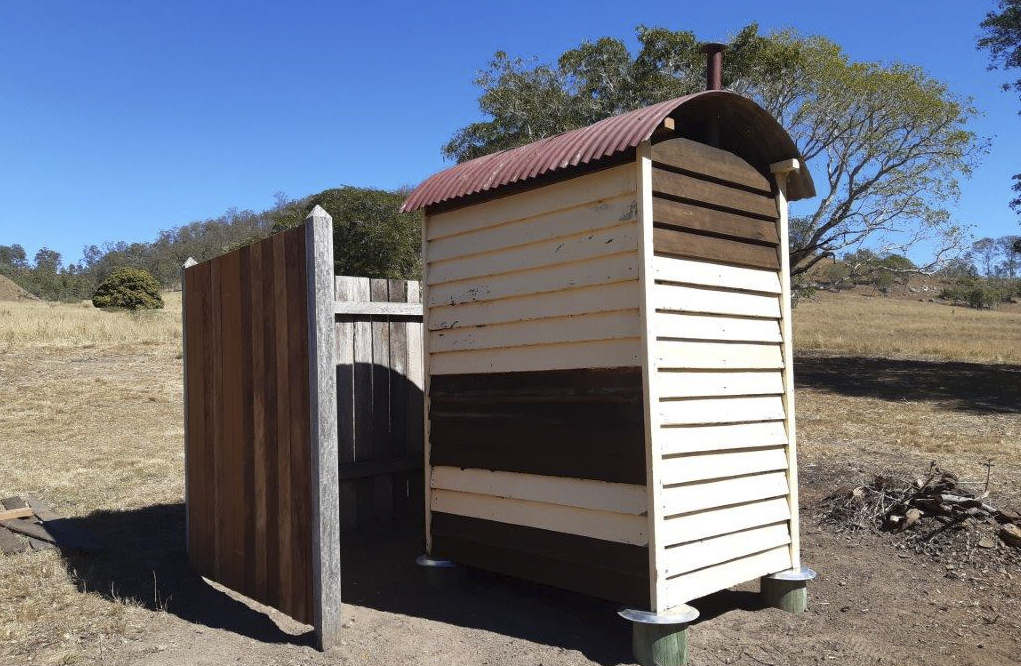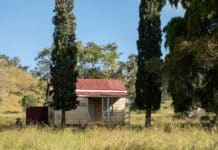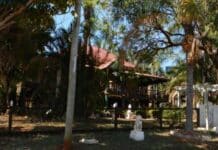
In what must be one of the more unusual jobs for a Council worker, historic toilets are being restored at the heritage-listed former Boolboonda State School 82km west of Bundaberg.
Council staff are working to carefully restore two “earth closets” found in the school yard, which dates back to 1896.
The small school building has a rich history and holds many memories for some of the region’s residents.
The school closed in 1973. It initially served as a provisional facility for the families of workers constructing the Boolboonda Tunnel.
A recent inspection found the two old-style toilets in disrepair and Council staff took on the task of restoring the structures to their original state.
According to the History of Sanitary Sewers: An earth closet uses dry earth to cover waste material for later removal. A design was patented in 1869, advertised as a great improvement over the cesspit.
Work on this project has a special meaning for Bundaberg Regional Council’s leading hand carpenter Dave Sauer.
During his 15 years with Council he has worked on heritage-listed buildings and structures across the Childers area.

“I take a lot of pride in restoring these structures as they were built by the old-school carpenters,” Dave said.
“I believe they should be maintained to their former glory as they all serve a purpose in our history, and in our future.
“Buildings from the past should never be forgotten, and if well maintained, these will outlast most modern-day constructions.”
Fleet and Trade Services supervisor Ben Pollock said his interest in the project was sparked by a family connection with Boolboonda.
“My father-in-law Peter Leather grew up on a nearby farm and was a student at the school,” he said.
“He speaks fondly of his time there and is planning to revisit the site soon to see the completed restoration work.”

Boolboonda heritage project extends to entire site
Venues and Facilities project officer Sam Dziril said repairing heritage-listed buildings wasn’t always straightforward.
“Once repairs are deemed as larger projects, we’re required to send in a photographic record to the Department of Environment and Science, and from there they give us strict guidelines to follow,” said Sam.
“Design and materials have to be the same or as close to the original as possible.
“In some cases, it even comes down to using the same nails if they’re visible.”
Sam said government regulations extend to the whole site, including plants and trees.
“Peter Beveridge and his crew from Council’s Parks and Gardens looked after weed management and removed two large dead trees that were unsafe,” he said.
“We are in the process of consulting with Council’s Arboriculture Coordinator to replace them with trees of similar type.”
The restoration work on the earth closet is expected to be completed next week with work to continue on tree planting and fencing.
Early history of Boolboonda
Boolboonda is 33km from Gin Gin.
According to the conservation management plan, prepared by Australian Heritage Specialists on behalf of Council, the area was originally settled by European pastoralists in 1847 when settlers Gregory Blaxland and William Forster moved into the region and set up a sheep station.
Settlers were brought to the Gin Gin area predominantly because of copper mines discovered in the Mount Perry area in the second half of the 19th century.
To accommodate the new industry, in 1878 the Queensland Railway network extended westward, with the Bundaberg to Mount Perry Line reaching Boolboonda on 13 of November 1883.
A major feature of the Mount Perry Line was the construction of the Boolboonda Tunnel, which begins 150 metres from the Boolboonda State Primary School.
This tunnel is the longest unsupported tunnel in the southern hemisphere, having burrowed through 192 metres of solid rock. The inclusion of this tunnel in the line made it easier to access Mount Perry.
The Mount Perry railway led to the formation of Boolboonda town around 1883 with agricultural selectors and railway workers coming to settle. Miners also made their way to the small township, exploiting the reserves of wolfram and molybdenite.
After closure in 1973, the Boolboonda State School grounds and building were held in trust by local residents and used as a community meeting area until the Kolan Shire Council became trustee in the early 1980s.
Some 18 teachers taught at the Boolboonda State School. The longest serving of these was Margaret Campbell who was teacher at Boolboonda from 1926 until 1958.







